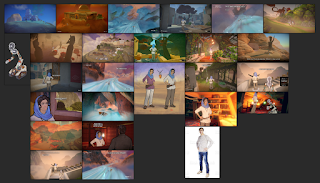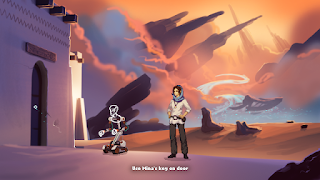I’m currently in New York City, and naturally met up with Mr Dave Gilbert for lunch, just to catch up and chat after over three years of not seeing each other in person. While we were chatting it occurred to me that it had been just over 10 years since Dave needed a new background artist for The Blackwell Epiphany, and asked if I’d be interested in the role. I’d done some animation work for Dave in the past, and some conceptual stuff, and I had reached a point doing low resolution adventure game graphics where I felt I could do a solid job of it.
A little over a year later we had completed the game, finishing up the series, and I think we knew then that we shared a vision. While our tastes and our skills are quite different, they complement each other well, and we feed off each other’s creative energy well. Along the way Dave had promised that he’d have enough work to pay me a regular wage, and so I handed in my notice at my old job and have been drawing for him ever since.
A decade after that email asking whether I’d like to take a stab at the backgrounds, I’m still doing this, and it’s been a decade with many ups and downs, but it’s been a rich experience overall. Epiphany was an interesting game for both Dave and I, and I think that sense of a shared vision we established in making it is something that has endured.
For me the most intimidating aspect of the project at the very start was the question of whether I had an endurance to do all the backgrounds and animations for a game of such a size by myself. Looking back now, it’s funny that this was my main concern - that decade has, if nothing else, proved my endurance through a project to myself. As with all work I can’t help but feel that I’d change so many things were I do do this game over. I doubt that feeling will ever truly go away.
Regardless, there was a special moment when I had this first scene painted up, and characters in and animations playing - the falling snow, a taxi driving past in the background, and just the colours and lights all working together in the composition and I sat back and thought “Yes, this is going to be good.” It’s that sort of feeling that drives me, more than anything else, and after a decade of this, I’m still doing my best to bring that feeling to life with each scene, in each project, and that’s still the best part for me. I hope to keep doing it for a while still.



























